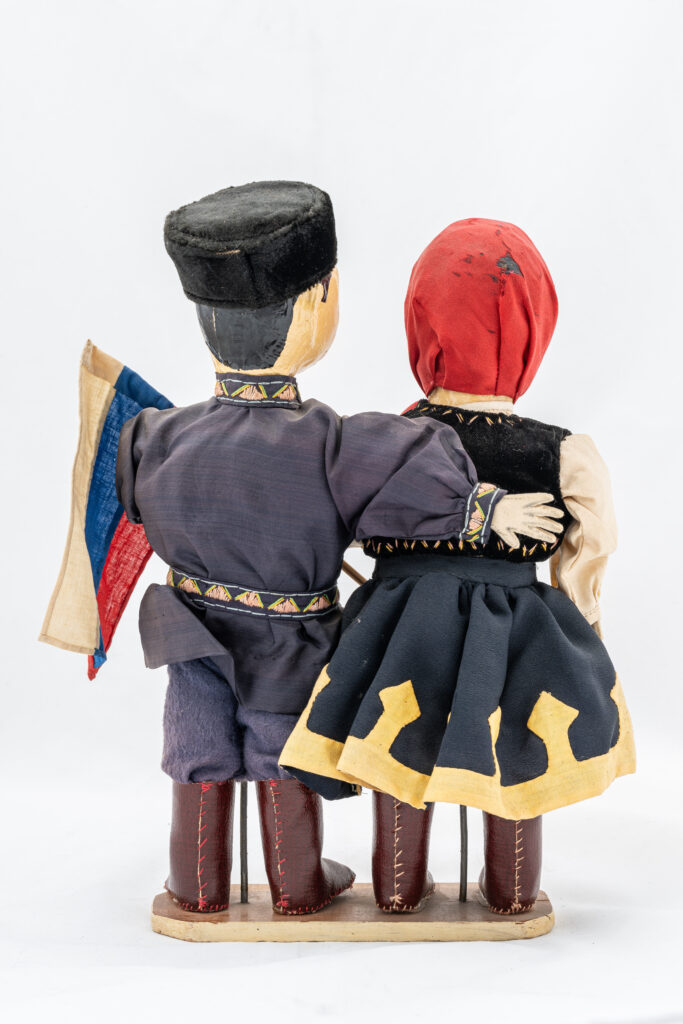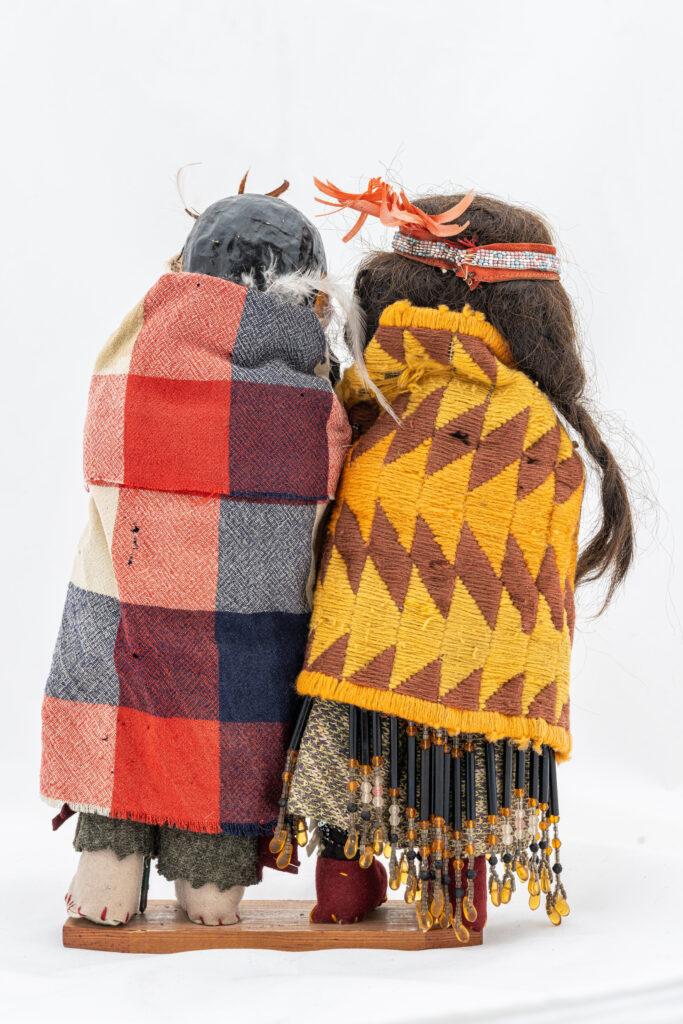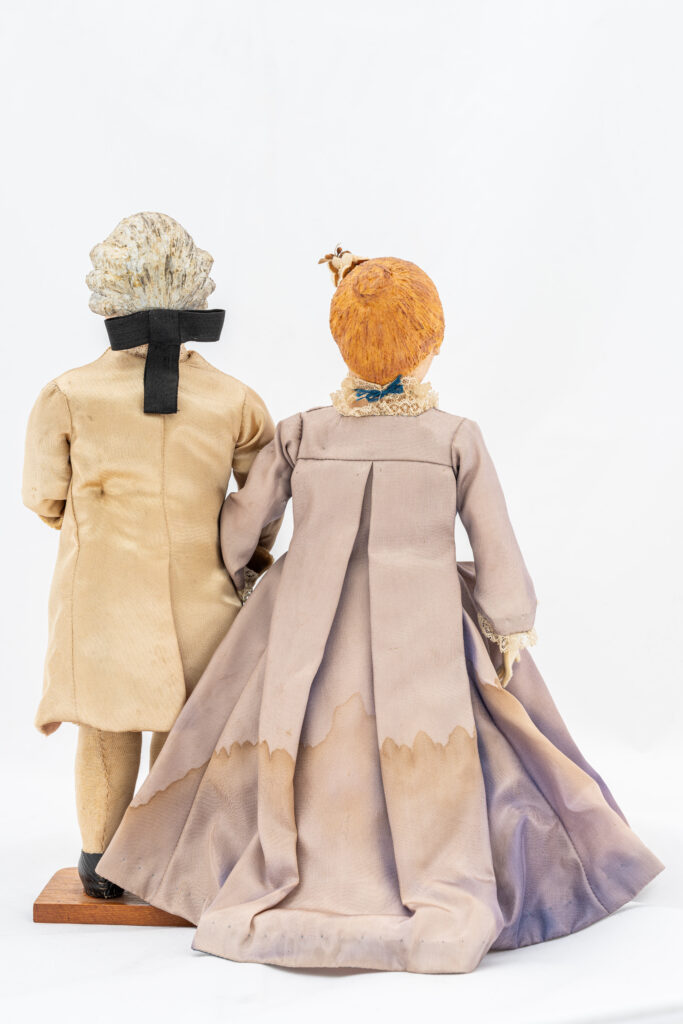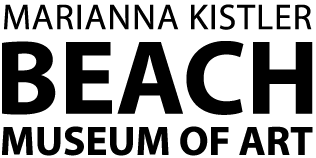A NEW DEAL IN KANSAS
“Rich in Relics of Indian Life”: Presentations of Indigenous Culture in Government Arts Programs
One of the lesser-known WPA arts programs was the Museum Extension Project (MEP), which provided hand-made visual aids for schools, libraries, and museums. These items were as varied as costume dolls, nature prints, history dioramas, and weaving kits.
Certain educational objects created for the MEP and other New Deals arts programs in Kansas sought to interpret Native American history and culture. While some of these presented, for the period, complex and nuanced views of Indigenous peoples, many promulgated negative stereotypes.
At the same time, after years of suppression, Native students were being encouraged to celebrate Indigenous cultures in federal boarding schools such as the Haskell Institute in Lawrence. Haskell superintendent Henry Roe Cloud (Winnebago Tribe of Nebraska) described Kansas as “rich in relics of Indian life” and in the early 1930s promoted the acquisition and study of Indigenous arts and artifacts and the development of an arts and crafts curriculum to preserve traditions and skills.
This change at Haskell would be aligned with what came to be called the “Indian New Deal.” While not without critics, its associated government programs did provide some economic relief to Native communities, including promoting art making as a source of income.
This image is part of Kansas Landmarks, a series of forty-nine prints Whittemore created for the Kansas MEP. The group includes prints of territorial capitols, courthouses, mills, windmills, homes of famous early Kansans such as John Brown and Carrie Nation, cemeteries, and even geological formations. The series contains four images of missions, including Shawnee Mission in Johnson County.
Shawnee Mission was established in 1839 by the Rev. Thomas Johnson of the Methodist Episcopal Church. Its purpose was to “civilize” Shawnee pupils and students from other tribes through manual training and a Christian education. Like most schools for Native Americans in the nineteenth century, this attempted assimilation forbid students from speaking their Indigenous languages, wearing Native clothing and hairstyles, or expressing other aspects of their cultures.
The Mission has been operating as a museum for almost a century under the Kansas State Historical Society and is also managed by the city of Fairway.
Shawnee Mission (North Building), ca. 1937, gelatin silver print, Margaret Evelyn Whittemore collection, Kansas State University Marianna Kistler Beach Museum of Art, Kansas Printmakers Fund, CM15.2018
Margaret Whittemore
Born 1897, Topeka, Kansas
Died 1983, Sarasota, Florida
Shawnee Mission, ca. 1937
Woodcut
7 x 9 in.
Kansas Museum Extension Project, Professional and Service Division, Works Projects Administration
Original location: Roosevelt Elementary School, Arkansas City
Birger Sandzén Memorial Gallery, Lindsborg, gift of Randal Lundberg, 2022.0022
M. Louise Kent
Born 1913, Clovis, New Mexico
Died 1980, Los Angeles, California
Corn Husk Doll 1860, Shawnee Mission, 1939
Watercolor on paper
Index of American Design, Kansas WPA Project
10 1/2 x 14 in.
Alice C. Sabatini Gallery, Topeka & Shawnee County Public Library
In 1927 the Kansas State Historical Society acquired the Shawnee Mission site with the aim of turning it into a museum. New Deal arts programs played a part in its renovation and in the documentation of its historical structures and artifacts. Margaret Whittemore’s ca. 1937 depiction of one of the mission’s buildings (at left) was created for the WPA’s Museum Extension Project (MEP). Kansas MEP artisans also created bed frames and desks for the mission.
Another connection to the renovated mission is this drawing of a corn husk doll, which Kent produced for the Index of American Design (IAD). A part of the WPA’s Federal Art Project, the IAD hired artists accomplished in drawing to create a compendium of American folk and decorative art, from the colonial period through the nineteenth century.
Kent’s doll was identified as the property of Edna Johnson Anderson (1853-1933), daughter of Shawnee Mission founder Rev. Thomas Johnson, who became the namesake of Johnson County.
Corn husk doll believed to be the model for Kent’s drawing for the WPA’s Index of American Design. Shawnee Indian Museum State Historic Site, Fairway
All Nations Figures or Foreign Costume Figurines (Russia), ca. 1938
Mixed media
Kansas Museum Extension Project, Professional and Service Division, Work Projects Administration, Wichita workshop
14 x 7 x 3 in.
Marshall County Historical Society Museum, Marysville
Costumed dolls were popular Museum Extension Project (MEP) items. (Scroll down to see more examples.) The dolls were provided to Kansas schools to teach children about contemporary and historic peoples through details such as clothing and hairstyles. At best, these dolls preserve cultural knowledge in miniature. At worst, they perpetuate stereotypes.
The MEP “American costume” doll sets are distinguished by historic period, ranging from 1607 to 1900. All are white and clothed in styles worn by Europeans and Americans of European descent. The “foreign costume” dolls bear the names of countries, most of them European.
In contrast, a set of Native American dolls from the “foreign costume,” or “All Nations,” series is identified only as “Indian.” The dolls’ clothing and accessories embody the stereotype of the “Pan-Indian.” The male doll’s blanket resembles Navajo weaving, while other features of his dress such as his headband and moccasins suggest that he is a member of a Plains tribe. The beadwork that adorns both figures cannot be easily attributed to any specific Native peoples.
Early Indian Life in Kansas, Series of Six Dioramas
Mixed media
Kansas Museum Extension Project, Professional and Service Division, Work Projects Administration, Lawrence workshop
22 x 35 x 20 in. (each)
Pony Express Home Station & Museum, Marysville
Click here to explore images and interpretations of the six Native American dioramas.
The exhibit also includes updated interpretations of the dioramas.
The Kansas MEP produced numerous 3-D miniature models, among them dioramas, which were a popular visual educational tool at the time. The 1939 Kansas MEP catalog asserted: “This realistic presentation makes the subject, which is now remote, more vital to both knowledge and appreciation.”
All of the MEP dioramas represent scenes that take place in what is now the state of Kansas, from the age of the dinosaur to the years of the Pony Express. Six MEP dioramas present Native American groups who had a presence in the region prior to European colonization. These dioramas offer more complex and sensitive portrayals of Indigenous peoples in contrast to other New Deal artworks, such as the dolls in this exhibition.
The six scenes are Cheyenne Buffalo Hunt, Kansas Harvest, Osage Elk Hunt, Pawnee Pottery Making, Comanches on the March, and Kiowa Eagle Dance.
Building WPA Museum Extension Project dioramas, Lawrence, Kansas
Kansas Memory, https://www.kansasmemory.org/item/14893
Woodrow “Woody” Crumbo
Bodéwadmik (Citizen Potawatomi)
Born 1912, Lexington, Oklahoma
Died 1989, Cimarron, New Mexico
Eagle Dance, ca. 1948
Screenprint
10 1/8 x 7 1/2 in.
Private collection, promised gift to USD 259 Wichita Public Schools
Crumbo was an artist, dancer, and flute player who sought to document and celebrate the traditions of Native American nations.
Crumbo attended the Wichita American Indian Institute, one of the first college preparatory schools for Native Americans. The school was founded by Henry Roe Cloud (Winnebago Tribe of Nebraska), an educator who became the first Native American superintendent of the Haskell Institute (now Haskell Indian Nations University) in 1933.
Crumbo went on to study art under Oscar Jacobson at the University of Oklahoma. During this time Crumbo supported himself by working as a dancer, which allowed him to engage with the ceremonial dance traditions of different tribes. His knowledge of these traditions is reflected in a series of prints he made in Taos, New Mexico, that depict Native American dances, including the Eagle Dance. Each print was accompanied by an explanation of the dance’s symbolism and common regalia.

Crumbo in Eagle Dance regalia, Taos, New Mexico, ca. 1950, (source: https://voicesofoklahoma.com/interviews/crumbo-halsey-minisa/)
Artists unspecified, Mshkodéniwék
(Prairie Band Potawatomi Nation)
“Indian Crafts,” Catalog, Visual Aids, Handicrafts, 1940
Beaded belts, hatband, necklace, moccasins, cradleboard; silver bracelets with hammered designs
Kansas Museum Extension Project, Professional and Service Division, Work Projects Administration, Mayetta workshop
Kansas State Archives
The items pictured here were crafted by members of the Mshkodéniwék, or Prairie Band Potawatomi Nation, for a WPA workshop in Mayetta. While the WPA did not originally credit the work of individual artists or the connection to Potawatomi culture, we can now identify the names of these artists from Bureau of Indian Affairs’ records—Henry McKinney, Josie McKinney, Rosanna B. Potts, John Shoptese, Minnie Marchno Shopteese, Henry Claybear Nahgonbe, and Rebecca Matt.
In this Museum Extension Project sales catalogue, the objects and their makers are introduced in general terms. They are described as “INDIAN CRAFT … “articles of beadwork, weaving and embroidery, clay, metal, and woodwork … made by Indians exemplifying their racial handicrafts.” Use of only the word “Indian” erases the artists’ tribal affiliations. The phrase “exemplifying their racial handicrafts” positions Indigenous peoples as an exotic “other.”
The Great Depression was especially hard for Indigenous communities. United States citizenship was only extended to Native Americans in 1924, and many still faced limitations on their rights, including movement on and off reservations for work. Government jobs were often the only option. Creators of these WPA-distributed items may have felt compelled to take these jobs, according to Tribal Historic Preservation Officer Raphael Wahwassuck, a descendent of workshop employee Henry Claybear Nahgonbe. Even given these circumstances, the skill and beauty of the beadwork of these Potawatomi artists is apparent. We can now properly attribute their work and celebrate their artistry.
Prairie Band Potawatomi artists in WPA workshop, Mayetta, Kansas, ca. 1937. Image courtesy Kansas State Historical Society, item 14891
Students examining Kansas MEP objects, location likely Topeka Public Schools Visual Education Library, ca. 1942–1943. Image courtesy Topeka and Shawnee County Public Library, WPA photography collection
Artists unspecified, Mshkodéniwék
(Prairie Band Potawatomi Nation)
Bandolier bag with pompons, ca. 1939
Satin, cotton, taffeta, wool yarn, beading
Kansas Museum Extension Project, Professional and Service Division, Work Projects Administration, Mayetta workshop
38 3/8 x 11 in.
Spencer Museum of Art, The University of Kansas, Lawrence, gift from the Menninger Foundation, 2007.1532
Bandolier bags, or Yaśhwango’gėn in Potawatomi, are large, fully beaded shoulder bags created and worn by the tribes of the Great Lakes—Potawatomi, Ojibwe, Menominee, Odawa, and Meskwaki. The artists of these bags were primarily the women of the tribes. The earliest bags were used as simple, functional bags to store personal items and were not as decorated as the bags made after the introduction of glass beads, yarn, and fabric. Precursors to the bandolier bag were smaller and decorated with quillwork, seeds, animal hair, and shells.
Starting in the nineteenth century, the bags evolved into the fully beaded, embellished bags seen today. They became less functional and more of a status symbol among the tribes, representing leadership and respect. They were given as gifts to individuals to honor their accomplishments. Men would wear them for community events, dances, portraits, and meetings with leadership outside of the tribe. In the 1870s and 1880s bags were used as a form of currency. Some of the Plains tribes would trade a horse in exchange for a bag.
There are no restrictions on who can wear the bags—men, women, and children can carry them. There are even records of bags being given to non-Natives as gifts. Today one can see these bags in the powwow arena worn primarily by the Woodland style dancers and jingle dress dancers.
—Tara Mitchell, Deputy Tribal Historic Preservation Officer, Prairie Band Potawatomi Nation, Mayetta
Sources: A Bag Worth a Pony: The Art of the Ojibwe Bandolier Bag by Marcia G. Anderson (2017); and the Prairie Band Potawatomi Language Department
Beadwork has been part of my life for as long as I can remember. I started beading at the age of 6 thanks to a Title VI* program my school offered to Native American students. During the last 28 years, I have gained a tremendous amount of knowledge about beadwork through research and the help of my Mother. The one lesson that I make sure to share with new bead artists or those who are interested in beadwork, is that you must always have a clear mind when creating your art. Pray for that person you are beading for, think good thoughts and those good thoughts and prayers will be passed on to the person wearing it.
When it comes to inspiration, I refer to our traditional Potawatomi designs. The Potawatomi are known for their intricate florals and use of color. If you look at older beadwork it was common for Potawatomi bead artists to outline their designs with white beads, and this is still a common practice among our tribal bead artists today. The art of beading is usually passed down from one family member to the next. I learned from my Mother and will pass this skill on to my children with hopes of them passing it on to their children.
*Title VI of the 1964 Civil Rights Act prohibits discrimination in education and addresses the educational and cultural needs of American Indian students.
Tara Mitchell, beadwork artist and descendent of Prairie Band Potawatomi WPA workshop member Rosanna B. Potts
Some students who arrived at Haskell before the 1930s had not been exposed to the rich arts and crafts traditions of their own tribes due to U.S. government policies such as removal and assimilation. Hoping to restore knowledge of these traditions and prepare students for the greater economic security that sale of high-quality handcrafts might offer, Haskell developed a program in arts and crafts during the early 1930s.
First-year students received a general education in the customs and arts and crafts of the various tribes across the United States. They then studied Plains and Woodland traditions. Next, they began Native beadwork, producing necklaces, bracelets, and belts. Once they had achieved sufficient mastery of bead working techniques, students moved on to producing dolls and beaded doll clothing.
Haskell students studied the design traditions of varied Native North American cultures. In this photograph from the 1930s, girls display their design studies and the finished handcrafts they produced as the result of exposure to Southwest designs, including those of the Pueblo and Hopi people. Duke D’Ambra photograph collection, KU Digital Libraries, RH PH 69
Marguerite M. Nellis
Born 1906, Topeka, Kansas
Died 1998, Seattle, Washington
Haskell Student, ca. 1939
Soft-ground etching
Works Progress Administration Federal Art Project
8 5/8 x 6 in.
Wichita Public Schools, USD 259, Robinson Middle School
Nellis created this image of an unknown student at the Haskell Institute as part of her employment with the WPA’s Federal Art Project. Nellis completed several prints for the FAP depicting unidentified Native American, African American, and Mexican American subjects.
The artist studied at the Art Institute of Chicago and with Mary Huntoon at Washburn College in Topeka.
Pearl Mo Nac (Creek/Mvskoke Nation)
Tipi, ca. 1940
Mixed media
H 17 x D 11 in.
Haskell Cultural Center and Museum, Haskell Indian Nations University
This miniature tipi featuring a traditional Plains shield design was made by Pearl Mo Nac, a Creek student at Haskell Institute. Girls who attended Haskell were trained primarily in domestic skills, including housekeeping, cooking, childrearing, and home entertaining. They also received instruction in Indigenous arts and crafts forms easily adapted to daily use in the modern home, and in the surface design traditions of Native North American cultures.
As part of their training, Haskell home economics students prepared and hosted luncheons and banquets for other students, teachers, administrators, and guests. These occasions provided the opportunity to create centerpieces, table runners and other decorations, thus allowing students to develop and practice handcraft skills. This miniature tipi may have been created for such an occasion.
One may question why a member of the Creek tribe, which historically occupied the American Southeast and lived in thatched-roof dwellings made with sugarcane and plaster, would create a Plains-style tipi. However, classes at Haskell included instruction in a wide range of Native American cultures, so students often produced objects representing tribes other than their own.
Artist unidentified
Polychrome vessel, ca. 1940
Glazed earthenware
H 9 x D 5 1/2 in
Haskell Cultural Center and Museum, Haskell Indian Nations University
In shape and color this vase resembles Pueblo pottery of the American Southwest, but its surface design shows a more modern and individualized aesthetic. Arts and crafts teachers at Haskell prepared students to work as summer camp counselors and handcrafts instructors throughout the country. As part of the training students studied Pueblo design traditions and then produced pots painted with designs of their own creation.
Bringer of the Mystery Dog. Šunka wan wak’an agli kin he, 1939
Lawrence, KS.: Education Division, Department of the Interior, Bureau of Indian Affairs, Haskell Institute Printing Department, 1943
Kansas State University, Marianna Kistler Beach Museum of Art, CM24.2023
In the early 1930s the Bureau of Indian Affairs expanded the printing program at Haskell Institute in Lawrence. Boys were trained to become professional printers, and, at the same time, their institution’s needs for printed materials were met. The Indian Readers Series, published by the bureau from 1934 to 1948, helped fill the need for bilingual readers.
White writer and educator Ann Nolan Clark was recruited by the bureau to adapt Native oral stories into English for the books, which featured illustrations by some of the best-known twentieth-century Native artists. Among them was Yanktonai/Dakota artist Oscar Howe. Trained at the Santa Fe Indian School, Howe conformed to the “flat-style” (using expanses of unmodulated color and black outlines) promoted at the school early in his career but soon developed his own style.
Adapted from Blackfeet oral legend regarding the origins of the horse and written in English and Lakota, Bringer of the Mystery Dog Sunka wan wak’an agli kin he tells the story of Little Dog, an adolescent who encounters a “mystery dog” and a Pawnee warrior. Little Dog brings them back to his village, giving his people their first horse.





























